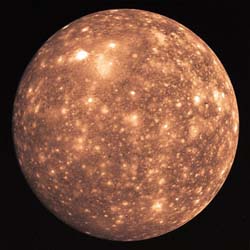
Photo from Voyager 2: http://sse.jpl.nasa.gov/ |
|
Callisto
Named after Callisto, one of Zeus's many love interests in Greek mythology.
The second largest moon of Jupiter and the third largest in the solar system, after Ganymede and Titan. Orbiting beyond Jupiter's main radiation belts, Callisto is the outermost of the Galilean satellites. It also has the lowest density of the Galilean satellites and probably a very different internal structure. The interiors of the other three big Jovian moons are thought to be completely differentiated, with clear boundaries between core, mantle, and crust. This is probably due to gravitational squeezing by Jupiter which helped keep the interior of the inner Galileans molten long enough for heavier materials to settle fully at the greater depths. Being further out, Callisto seems to have arrested early in its development so that its internal rock is not fully segregated. Measurements by the Galileo spacecraft have, however, been interpreted by some researchers as pointing to the existence of a subterranean watery ocean on Callisto, of the kind hypothesized for Europa.
Callisto's surface, the darkest of any of the Galilean moons (although still twice as bright as our own Moon), is the most heavily cratered of any object in the solar system, testifying to an almost complete absence of geological activity over the past 4 billion years. Indeed, Callisto is the only body greater than 1,000 km in diameter which shows no signs of having undergone any significant resurfacing since the end of the early bombardment phase of the solar system about 3.8 billion years ago. Its surface features are dominated by shallow impact craters and rings. Two large features, Valhalla and Asgard, which resemble bullseyes, are believed to be the remains of massive impacts. Seven chains of impact craters have been mapped and are thought to have been formed when comets were broken up by Jupiter's gravity and collided with Callisto. In February 1999, the discovery was announced, based on measurements taken by Galileo's near-infrared mapping spectrometer, of carbon dioxide ice on Callisto's surface together with a very tenuous atmosphere of carbon dioxide. Since this gas must constantly leak into space under the action of ultraviolet rays from the Sun, it must be continuously replenished, possibly by venting of carbon dioxide from the interior. This discovery means that all four Galilean moons are now known to have thin atmospheres.
| Callisto facts |
|
| Discovery: |
Jan 7, 1610 by Galileo Galilei |
| Diameter (km): |
4,806 |
| Mass (kg): |
1.08E+23 |
| Mass (Earth = 1) |
1.81E-02 |
| Surface Gravity (Earth = 1): |
0.127 |
| Mean Distance from Jupiter (km): |
1,883,000 |
| Mean Distance From Jupiter (Rj): |
26.6 |
| Mean Distance from Sun (AU): |
5.203 |
| Orbital period (days): |
16.68902 |
| Rotational period (days): |
16.68902 |
| Density (gm/cm?3) |
1.86 |
| Orbit Eccentricity: |
0.007 |
| Orbit Inclination (degrees): |
0.281 |
| Orbit Speed (km/sec): |
8.21 |
| Escape velocity (km/sec): |
2.45 |
| Visual Albedo: |
0.19 |
| Subsolar Temperature (K) |
168 |
| Equatorial Subsurface Temperature (K) |
126 |
| Surface Composition: |
Dirty Ice |
Text from David Darling’s encyclopedia. |